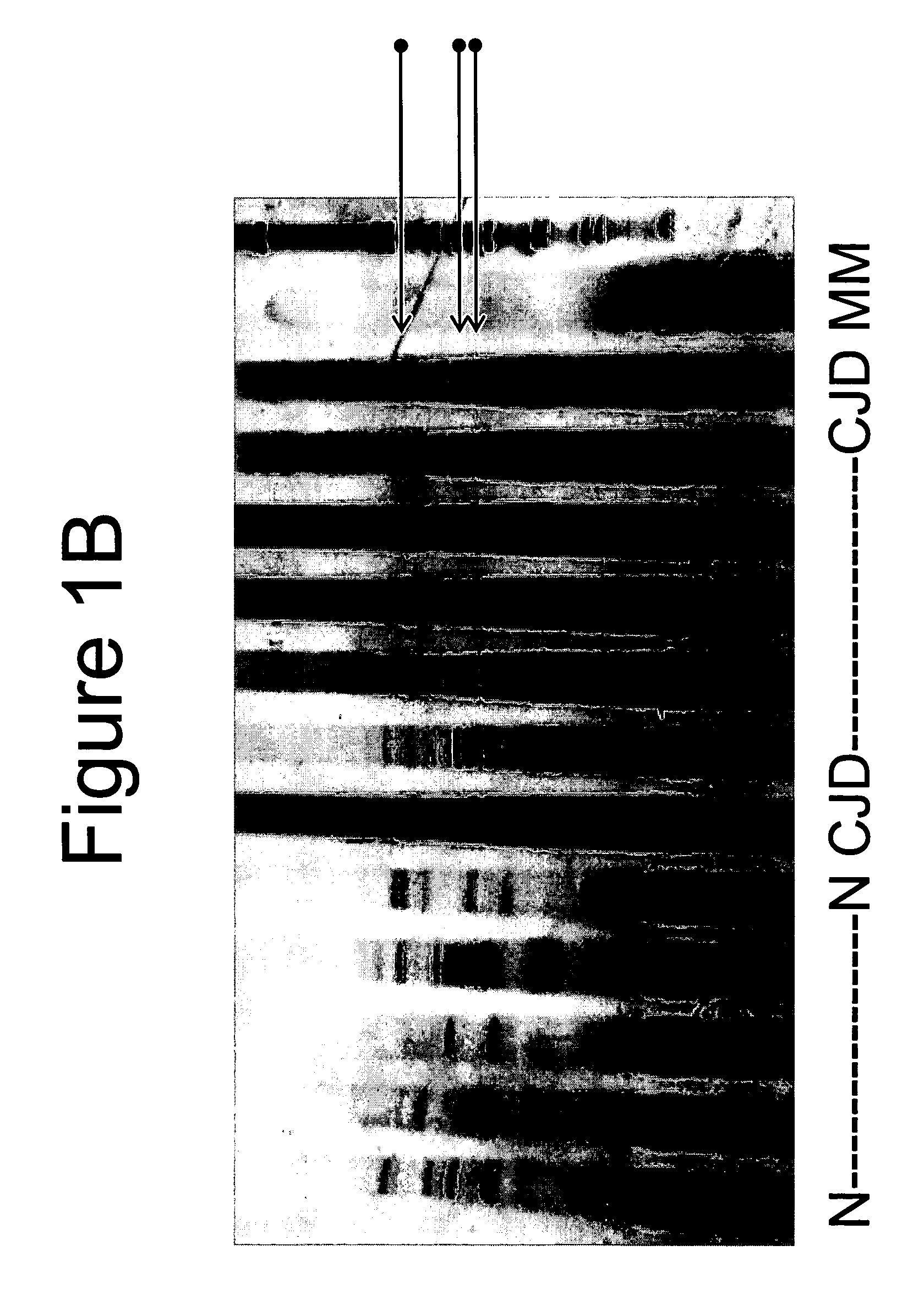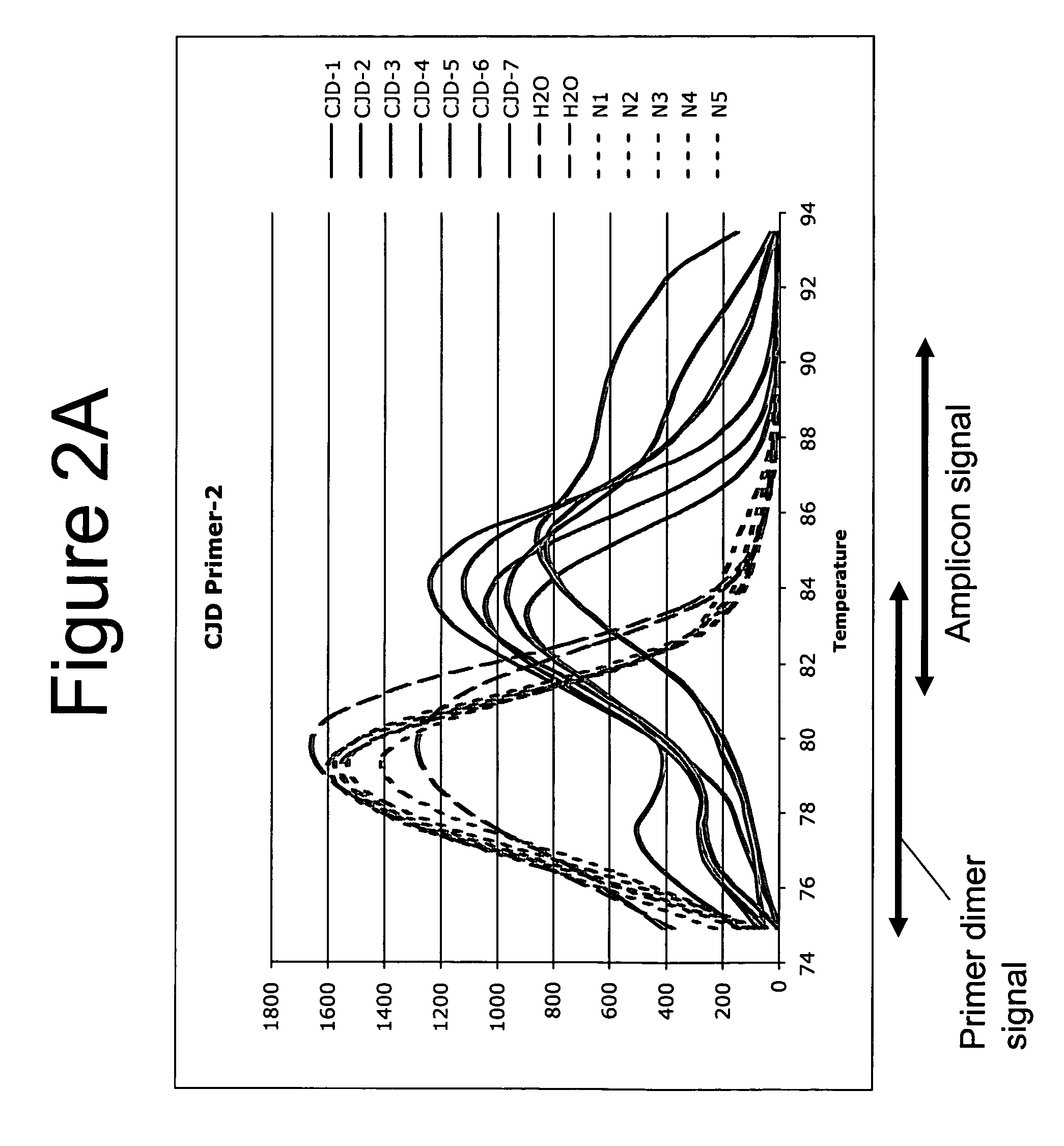Detection of nucleic acids to assess risk for Creutzfeldt-Jakob disease
a technology of creutzfeldt-jakob disease and nucleic acid detection, which is applied in the direction of microbiological testing/measurement, biochemistry apparatus and processes, fertilization, etc., can solve the problem of no reliable method for determining whether a patient is healthy or no
- Summary
- Abstract
- Description
- Claims
- Application Information
AI Technical Summary
Benefits of technology
Problems solved by technology
Method used
Image
Examples
example 1
Detection of Individuals at an Increased Risk for CJD
[0064] This example describes detection of CJD CNA. In summary, a PCR using non-coding region primers in a differential display approach was used on the sera from six confirmed cases of CJD, two presumptive clinical cases of CJD and eight healthy, laboratory volunteers. All eight sera from CJD confirmed and two presumptive cases were reactive in the assay. None of the eight healthy volunteer samples were reactive. Cloning of the reactive PCR products revealed human germ-line rearranged sequences. All sequenced PCR CNA fragments from CJD patients shared a 27-mer base sequence homologous to the Alu consensus sequences.
Experimental Protocol
[0065] Human subjects: Sera from CJD patients were obtained from the laboratory of Dr. Walter Schulz-Schaeffer. Sera from normals were drawn from ten volunteers.
[0066] Serum collection: Special care was taken in collection, processing and storage of serum samples. Blood from a suitable vein wa...
example 2
Blind Study Detecting CJD Samples
[0080] In a blind study to detect CJD, 10 blinded samples were evaluated. Samples were kept frozen until the day of nucleic acid extraction. The following samples were used for CNA extraction and polymerase chain reaction (PCR):
[0081] 10 unknown plasma samples (labeled CJ-2-99-126, CJ-2-99-152, CJ-2-99-153, CJ-2-99-176, CJ-2-99-177, CJ-2-99-178, CJ-2-99-181, CJ-2-99-192, CJ-2-99-206, CJ-2-99-214;
[0082] 2 archived Chronix Biomedical positive CJD samples (Pos Control-125, Pos Control-144); and
[0083] EDTA-plasma samples from 2 healthy blood donors (CJ-2-New-Ch, CJ-2-New-Ju).
[0084] Frozen plasma or serum was thawed at 4° C. in an ice-water bath and 200 μL were transferred into a 1.5 mL microcentrifuge tube. The tube was centrifuged at 4,000× g for 25 min at 4° C. in a Model 5214 bench top centrifuge (Eppendorf, Hamburg, Germany) to remove cell debris. The supernatant was transferred into a fresh tube and subjected to 35 min centrifugation at 20,000×...
example 3
Evaluation of False-positive Samples
CNA Test for CJD
[0092] In Example 2, results of the melting curve after 28 cycles and 30 cycles of amplification were presented. This example presents PCR data comparing 28 and 30 cycles from a new run of retained frozen, extracted DNA from false-positive samples.
Additional Samples
[0093] Blood donors: Ninety-two samples from blood donors were provided by the Blood Bank of the University Clinics Göttingen (UKG). These samples were divided into groups and stored for various recorded times at RT before serum separation. One additional group was kept cold before centrifugation.
[0094] Frozen retained samples: The following samples were used for CNA extraction and polymerase chain reaction (PCR). Samples 425157, 421559 and 421563 were the three serum samples from Göttingen's Universitätsklinik Blood Bank that had shown false-positive reactions in the CJD blood test. The retained extracted DNA (extraction performed as in Example 2) from these fals...
PUM
| Property | Measurement | Unit |
|---|---|---|
| Fraction | aaaaa | aaaaa |
| Melting point | aaaaa | aaaaa |
| Fluorescence | aaaaa | aaaaa |
Abstract
Description
Claims
Application Information
 Login to View More
Login to View More - R&D
- Intellectual Property
- Life Sciences
- Materials
- Tech Scout
- Unparalleled Data Quality
- Higher Quality Content
- 60% Fewer Hallucinations
Browse by: Latest US Patents, China's latest patents, Technical Efficacy Thesaurus, Application Domain, Technology Topic, Popular Technical Reports.
© 2025 PatSnap. All rights reserved.Legal|Privacy policy|Modern Slavery Act Transparency Statement|Sitemap|About US| Contact US: help@patsnap.com



